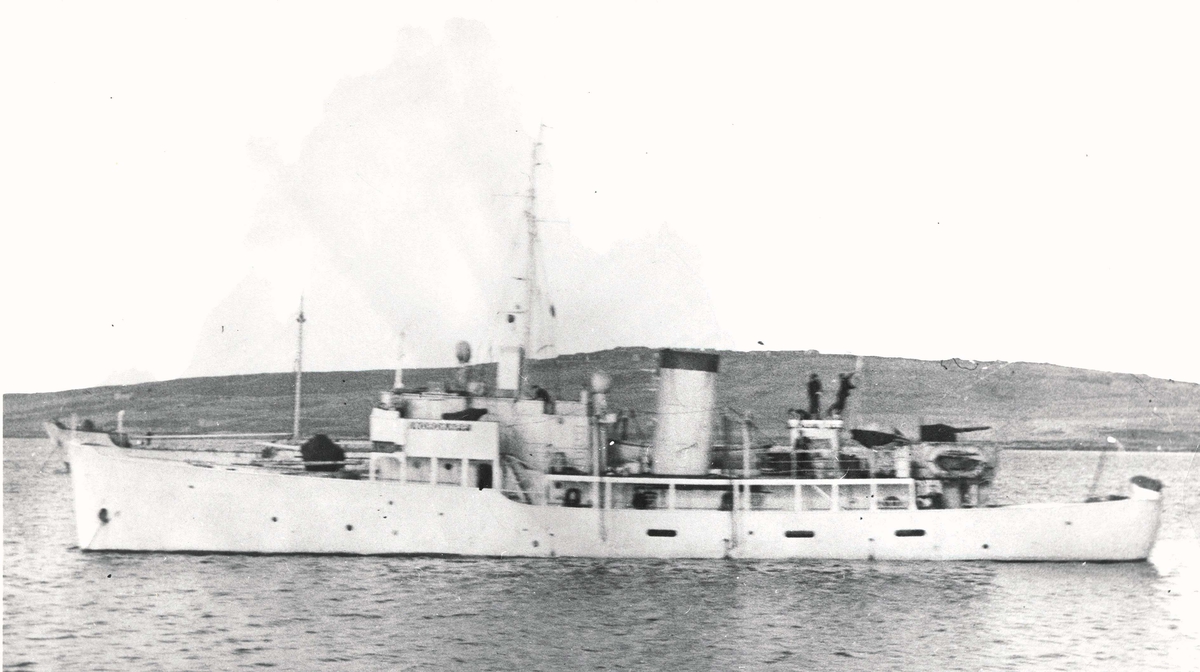
TYPE: Patrol vessel
CLASS: Nordkapp class patrol vessel
BUILDING SITE: Marinens Hovedverft, Horten
BUILDING NUMBER: 123
LAUNCHED: 18 August 1937
IN COMMAND: 1937 - 19.07.1954
ARMAMENT 1937
Spoiler
- 1x 47mm cannon
-Placement: aft as seen in the picture above
ARMAMENT 1943
Spoiler

-
1x 76mm L/40 Armstrong Whitworth cannon
-Barrel length in caliber: L/40
-Placement: Bow, just in front of the wheelhouse -
1x 20mm Oerlikon Mk.II
-Barrel length in caliber: L/70
-Placement: Aft, just in front ot the depth charge system
-Total gun barrel weight: 68.04 kilograms
-Minus breech mechanism: 20.86 kg
-Overall: 2,210 mm
-Barrel length: 1,400 mm
-Shell L70: 20×110mmRB
-Rate of fireL70:
-Cyclic: 450 rounds per minute
-Practical: 250-320 rounds per minute
-Muzzle velocity L70: 820 m/s
-Effective firing range L70:
-Against low-flying aircraft (HE round): 914 m
-Maximum firing range HE round at 45°: 4,389 m
-Feed system: Cylindrical magazine holding 60 rounds, Later adjusted to be a belt fed gun -
4x1 12.7x99mm Colt Browning MG/52
-Cooling system: water
some sort of turret, 4x mg’s in one but i cant figure out what it is -
12x Depth charges
-Racks: 2x Racks
-Reserve stowage: 2x depth charges on each sides of the vessel, shown at the drawings.
TECHNICAL DATA
Displacement: 234 Metric tons standard
Length: 39.77 Meter
Width: 6.55 Meter
Depth: 2.28 Meter
MACHINERY
2x Sulzer Diesel Engines
Power: 580 AHP
Speed: 13.7 Knots (25.37 km/h)
Bunkers: 30 Metric Tons of diesel oil
Range: 3200n. miles at 11 knots (20.37 Km/h)
CREW
Estimated crew: 28 Men
TIMELINE OF IMPORTANT EVENTS
1937: Launched
1940: Sunk the German tanker Kattegat off Glomfjord on 9 April
1940: Sailed from Svolvær to Thorshavm in the Faroe Islands on 12 June
1943: Stationed in Iceland
1944: Stationed in Scapa Flow
1945: Back to Norway 20 May
1954: Command deleted
1956: Sold for conversion to fishing vessel, new name Skarodd
1971: New name Tor-Hugo
1972: Wrecked while fishing off Mauritania
HISTORY
The head of the High Command of the Navy, Rear Admiral H. E. Diesen, came to London after the capitulation in Northern Norway on 19 June 1940, and the next day, 20 June, the High Command of the Navy was established in Great Britain with a staff of three officers and offices in Norway House, London. The chief of staff was Commander Captain E. C. Danielsen. The vessel material at the disposal of the High Command of the Navy in Great Britain at the end of June 1940 consisted of a submarine B 1, two destroyers Draug and Sleipner, two motor torpedo boats M.T.B. 5 and M.T.B. 6 three surveillance ships Fridtjof Nansen, Heimdal and Nordkapp and seven guard boats Bjerk, Syrian, Børtind, Nordhav II, Thorodd, Honningsvåg and Hval Vs. A total of 15 vessels. At the same time, the Navy’s personnel strength in Great Britain was about 80 officers and 520 quartermasters and enlisted men.
The surveillance ships Fridtjof Nansen and Nordkapp and the guard boat Honningsvåg were sent to Iceland as soon as they had become operational, to reinforce the British naval forces there. In the spring of 1943, the armed sloops Haugen, Lygrefjord and Sjølivet were stationed in Lerwick in Shetland and subordinated to the commander of. Shetland Division. They were mainly used for transport service at the port of Lerwick, but they also carried out certain special missions, particularly minelaying on the west coast of Norway. Beyond the autumn of 1943, the patrol vessels Horten, Molde, Narvik, Nordkapp and Risør were also stationed in Lerwick and administratively subordinated to the chief of the Shetland department. But operationally they came under British command.
In the same autumn, a further nine British motor torpedo boats became Μ.Τ.Β. 666, 669, 675, 681, 683, 684, 685, 686 and 687 of the 34th and 58th Motor Torpedo Boat Flotillas stationed in Lerwick with the same operational field and mission as the Norwegian Motor Torpedo Boat Flotilla. And beyond the winter of 1943-1944, they carried out ship traffic partly alone and partly together with Norwegian motor torpedo boats in the Norwegian shipping lane. operations against the German
Operationally, the British motor torpedo boat flotillas were under the same British admiral (A.C.O.S.) as the Norwegian flotilla. But the boats, like the Norwegian motor torpedo boats, received their operational orders from the commander of the Shetland division. In September 1943, the patrol vessel Nordkapp was also transferred from the Navy’s Islands Department to Shetland and operationally and administratively subject to the same authorities as the other patrol vessels.
The vessels’ mission was patrolling in the waters off Shetland and escorting in the waters between Lerwick and Scotland (Scapa Flow, Loch Ewe and Aberdeen etc.) and the Faroe Islands. In addition, some of the vessels were used a couple of times to tow motor torpedo boats from Lerwick to the Norwegian coast. During the stationing in Lerwick, the patrol vessels, with the exception of Nordkapps2, were constantly out on patrol and escort duty. From 1 September to 31 December 1943, Risør thus had an unsailable distance of 4,927 n. miles and Horten an unsailable distance of 5,163 n. miles. Narvik had in November and the month of December, a total of about 2,400 n. miles sailed. And Molde had from 11 November to 31 December 1943 a distance sailed of about 2,300 n. miles. During none of the operations did the patrol vessels come into contact with enemy combat forces.
IN GAME
Not the greatest speed, but i don’t think speed is the most important thing, but firepower. It doesn’t have the greatest firepower, but with 1x powerful 76mm cannon, 1x 20mm autocannon and 4x 12.6mm machineguns in addition to depth charges i believ e it could do quite good at the right battlerating
DRAWING OF THE VESSEL, LAYOUT AND PLACEMENT OF WEAPONS/EIGNE

76MM CANNON BEING FIRED


ALBUM
Spoiler
SOURCES
Spoiler
Nasjonalbiblioteket
Redirecting...
Norske Marinefartøy – Bodoni Forlag
Leselystig 39: Modeller som forteller – Norsk Marinehistorie | Polar Coordinate
page=83&fbclid=IwZXh0bgNhZW0CMTAAAR3GhssvWgyD0w_MD1vH_Hjd-v_Qa2eC_ZXV1YYohbIbkmtn7th0kV1jHaU_aem_NjiEFh1X-HovvWgOP_z8zw&searchText=ris%C3%B8r
Oerlikon 20 mm cannon - Wikipedia
Nasjonalbiblioteket
- Yes
- No